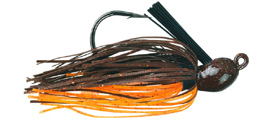All About Bass Fishing - Guide To Fishing Mid-Depths With Jigs
By Rick Seaman and Dan Westfall
 Choose a jig for fishing in mid-range depths as a bait that will cover lots of water in a relatively short period of time. If you are fishing points or flats with heavy wood or brush, weedless jigs would be the best choice. In areas with limited brush, an open-hook jig is often the best choice.
Choose a jig for fishing in mid-range depths as a bait that will cover lots of water in a relatively short period of time. If you are fishing points or flats with heavy wood or brush, weedless jigs would be the best choice. In areas with limited brush, an open-hook jig is often the best choice.
3 Most Important Factors About Fishing Mid-Depths With Jigs
- Finding cover on outside structure is the key to finding good jig fishing water.
- Selecting the right weight jig is critical – the deeper you fish, the heavier the jig head.
- Use a fishing rod designed for jigs and use heavy line – minimum 12 lb monofilament.
3 Most Effective Fishing Methods
- Must allow the lure to hit bottom after every movement.
- Visualize your jig as a live crawfish or baitfish swimming in and around cover on the bottom.
- Start fishing the jig at a fairly rapid pace pausing only to allow the jig to touch bottom and go again.
A jig can be one of the most productive mid-depth lures
 Generally speaking, a jig must fall back to the bottom after every movement of the lure to be most effective. Begin by lifting and moving the jig a foot or more, then allow it to come to rest on the bottom before moving it again. Start with a fairly fast, aggressive lift. Then slow down the retrieve and action when the bass are not responding to the more aggressive movement.
Generally speaking, a jig must fall back to the bottom after every movement of the lure to be most effective. Begin by lifting and moving the jig a foot or more, then allow it to come to rest on the bottom before moving it again. Start with a fairly fast, aggressive lift. Then slow down the retrieve and action when the bass are not responding to the more aggressive movement.
Line watching is critical to jig fishing. If you are not aware when the jig stops, you may not be aware when a bass grabs the lure either. Watch your line and notice what it does when the jig stops – it goes slack. The lure has either hit bottom or a bass has eaten it. Most jig bites come while the bait is falling and the line will go slack just the same as it would when the lure hits bottom. In either case it is time for you to move the lure or set the hook.
To get familiar with jig fishing, begin by allowing the lure to initially stop on the bottom and immediately reel 3 very fast cranks of the reel handle, followed by a pause to allow the jig to return to the bottom. Repeat this over and over until you are at the end of the cast. You can vary the number of turns and the speed of the cranking to achieve a variety of actions.
If you have difficulty seeing your line while fishing a jig, switch to high-visibility line so you can see the line come to a stop or see it twitch when an active bass grabs the lure. Based on your equipment and the type of cover you are fishing, use the heaviest line that is comfortable for the weight jig you are throwing.
For these depths, select a weight between 1/4 ounce and ¾ ounce. Start somewhere in the middle and adjust based on conditions. If you want to fish faster or deeper use heavier jigs. If you want to fish shallower or slower use lighter jigs. Regardless of the weight you are using, it is important to watch the line at all times to detect strikes and/or contact with the bottom. Select a fishing rod based on the weight jig you are throwing. A good place to start is with a medium action rod with enough sensitivity to help detect strikes.
Boat position is critical when fishing jigs. Find the ideal spot to cast from and keep boat movement to a minimum. This allows you to cover an area thoroughly before moving to the next section of the area.
AA Bass Fishing Knowledge Base
- Bass Fishing Overview
- Life Cycle Of Bass
- Seasonal Bass Migration
- Bass Migration - Mid to Late Winter
- Bass Migration - Spring
- Bass Migration - Early Summer
- Bass Migration - Late Summer
- Bass Migration - Fall
- Bass Migration - Early Winter
- Fishing For Bass
- It's Now WHAT You Throw, It's WHERE
- Research The Fishery Before You Go
- Review Contour Maps
- Types Of Cover Used By Bass
- Bass Fishing In Grass Beds
- Bass Fishing In Wood & Timber
- Bass Fishing In Brush & Vegetation
- Establishing Patterns
- Learn To Recognize Bites
- Review Lunar Tables
- Choose The Right Lures
- Find Bass Based On Conditions
- Conditions - Fold Fronts
- Conditions - Wind
- Conditions - Cloudy Days
- Conditions - Fishing In The Rain
- Conditions - Water Clarity
- Conditions - Rising Water
- Conditions - Falling Water
- Conditions - Fishing At Night
- Equipment & Tackle
- Equipment - Fishing Rods
- Equipment - Fishing Reels
- Equipment - Fishing Line
- Equipment - Fishing Lures
- Fishing With Live Bait
- Shallow Water Techniques, 0 -10'
- Shallow Fishing - Spinnerbaits
- Shallow Fishing - Crankbaits
- Shallow Fishing - Top Water
- Shallow Fishing - Pitching & Flipping
- Shallow Fishing - Artificial Worms
- Shallow Fishing - Jigs
- Shallow Fishing - Flukes
- Shallow Fishing - Stick Worms
- Shallow Fishing - Swimbaits
- Fishing Mid Range Depths, 10' - 25'
- Mid Depth - Spinnerbaits
- Mid Depth - Deep Diving Crankbaits
- Mid Depth - Artificial Worms
- Mid Depth - Jigs
- Mid Depth - Swimbaits
- Fishing Deep Water & Structure
- Fishing Deep Water - Jigs
- Fishing Deep Water - Jigging Spoons
- Fishing Deep Water - Artificial Worms
- Planning Your Attack
- Bass Fishing Questions & Answers
- Conservation - Protect The Fishery
Bass information by state
101624
Fishing Information



